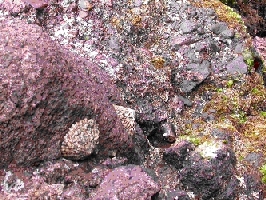Marine invertebrates: iron limpet
The ferrugine limpet (Patella ferruginea) is a limpet (marine gastropod mollusk) striking for its large size and thick radial ribs, which lives exclusively in the western Mediterranean. It is one of the most emblematic species from the point of view of the conservation of the marine environment in the Mediterranean, as it is probably the species most threatened with extinction in this sea.
Currently, its known distribution is limited to the coasts of North Africa, from the Strait of Gibraltar (Ceuta) to Tunisia, and to some points in southern Spain (coasts of Cádiz, Málaga, Granada and Almería), the island of Alboran, Corsica and northern Sardinia, some small archipelagos in the vicinity of these two islands and in the Sicilian channel.
In Spain, it can be estimated that the total number of specimens of Patella ferruginea would be between 89,000 and 108,000, with the majority of them found, in order of importance, in the Chafarinas islands (more than 45% of the total), Ceuta (27-28 %) and Melilla (21%), where they constitute breeding populations. The total contingent of specimens existing in the south of the Iberian Peninsula can be estimated at around 700 specimens, to which we must add more than 350 specimens from the island of Alborán.
Due to human pressure, the species has been disappearing from large areas, especially from the northern Mediterranean basin and, over the past century, it has been relegated to the western sector of the North African coast and to isolated points in southern Africa. Spain, Corsica and Sardinia and some small islands in the central Mediterranean. The decline of the species continues alarmingly today and many of its populations are on the verge of disappearing. All of this has led to this limpet appearing on various lists of threatened species, such as the Habitats Directive or the Berne and Barcelona Conventions.
The species has been included since 1999 in the “endangered” category of the Spanish Catalog of Endangered Species. For this reason, and in accordance with the provisions of Law 42/2007, of December 13, on Natural Heritage and Biodiversity, actions must be carried out for the conservation of the species in the three communities where it lives (Andalusia, Ceuta and Melilla), as well as on the Chafarinas islands.
For this reason, and based on article 57 of the aforementioned Law 42/2007, the Ministry of the Environment launched a Working Group on the species in 2007, in order to prepare a Conservation Strategy proposal. For this, the information obtained through a collaboration agreement with the National Museum of Natural Sciences was used, whose work took place between 2004 and 2006.
Representatives of the Autonomous City of Ceuta, the Regional Government of Andalusia, the former General Directorate of Coasts of the Ministry of the Environment, the University of Seville, the University of Valencia, the Autonomous University of Madrid, the National Museum of Natural Sciences, the former General Directorate for Biodiversity of the Ministry of the Environment and the Autonomous Organization of National Parks.
Finally, the National Strategy was approved by the Sectoral Environment Conference on May 30, 2008.



No hay comentarios:
Publicar un comentario